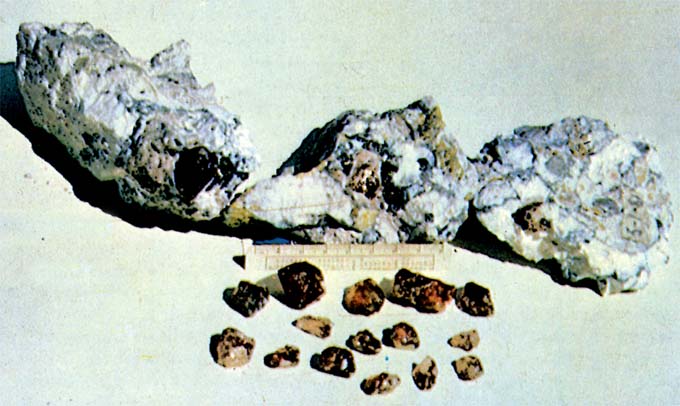Spinel was relatively recently identified as an independent class
Spinel
The chemical formula is MgAl2O4
Chemical composition (%): Mg 28.2, Al2O3 71.8.
Impurities: FeO, Fe2O3, ZnO, MnO, Cr2O3.
Spinel is close to corundum, but it is an oxide not only of aluminum, but of aluminum and magnesium.
Singonia: cubic. The shape of the crystals is octahedral or in the form of flat triangular plates bifurcated in corners. Crystals are usually small, sometimes large (up to 28 cm), but they are not whole and transparent. Characteristic are twins according to (111), octahedra fused along the faces-planes of the closest packing of oxygen. This characteristic way of twinning is called "according to the spinel law".
Color: different, due to admixtures of Fe 2+, Cr 3 + ions, etc. Spinel species are known: chlorpine spine - bottle green, picotite - red ruby, rubicell - orange, pleonast - brown. The presence of manganese gives a lilac shade. Spinel is characterized by uniform coloration in all directions of the crystals.
Hardness: 8, impurities Fe2O3 and Cr2O3 reduce it to 7.5-7.
Density: 3.5-3.7 g / cm3.
Cleavage: imperfect, parallel to the edges of the octahedron.
Transparency: transparent.
Glitter: bright glass.
Light refraction: n = 1,717; For the blue stones n = 1,715-1,754; For the red n = 1.715-1.735.
Dispersion: 0.020.
Pleohroizm: absent.
Absorption: 687, 675, 684, 685.5 nm; For pink spinel, the absorption intensity is weaker.

Spinel. Pamir.
On the origin of the name of the mineral there is no unified opinion. (The synonym for "lal" is a noble spinel.) Some researchers associate its name with the French spinelle - spike, others - with the Greek "spark", by association with the red varieties of the mineral. Pikotite is named after the first researcher who described chrome spinel.
Pure spinel is colorless and very rare. A frequent defect in crystals - light turbidity ("milk") does not affect the aesthetic perception and commercial value of spinel.
As jewelry stones, only crystal clear, crack-free crystals are used. Spinel cut diamond, stepped or combined, occasionally cabochon.
Occasionally, spinel has asterism (radiant stars), unlike corundums, which has only four rays; This phenomenon is explained by the definitely oriented arrangement of inclusions of needle crystals of rutile. The formation of spinel is associated with processes of regional metamorphism. The fine impregnation of spinel occurs in ancient metamorphic complexes.
The most beautiful spinel is formed on the contact of magnesium-containing carbonate rocks with granitoids. The most popular pink Badakhshan spinel, known in Europe since the XIII century, since the days of Marco Polo, who visited the high-mountain copy of Balas in the Pamirs and collected there a pink spinel, found together with a ruby, apparently, and at that time received the name of the bal-ruby (A new stone, like a ruby).
Large crystals of bright pink spinel (lala), usually exceeding the size of rubies, adorned the royal regalia and church utensils. A unique dark red spinel crowns the imperial crown of Catherine II.
Spinel is used for inserts in expensive jewelry, often in combination with diamonds, pearls. The increased level of diagnostic methods in recent years has made it possible to establish that the most famous gems, considered rubies, gems in the treasury of England "Rubin Timura" weighing 361 carats and about the same "Ruby of the black prince" are ruby spinel.
The only deposit in the CIS of the noble spinel Kukhilal, known from the 9th century, is in the south-west of the Pamir and is being developed by underground mining. Spinel was found on the river. Kamenka in the Southern Urals (crystals of emerald green color), as well as in the area of the lake. Baikal (blue and violet crystals).
Popular gems, which are represented on the territory of the CIS (former USSR)
- Diamond is the hardest and one of the most expensive minerals in the world
- Alexandrite (chrysoberyl) - one of the rarest and original stones
- Beryl (group of beryl) - heliodores, emeralds, aquamarines, morganites
- Turquoise - blue and green precious stone of the East
- Granat (group of pomegranates) - popular inexpensive gems
- Jadeite is a popular stone used in the Neolithic
- Pearls - traditional and favorite decoration of the Slavs
- Quartz (a group of quartz) is an extremely popular mineral in collections
- Corundum (group of corundums) - colorless corundums, rubies and sapphires
- Lazurite - blue stone of the high blue mountains of Pamir and Afghanistan
- Malachite - the Ural malachite is considered the best in the world
- Jade is the sacred green stone of Chinese emperors
- Feldspars - Labrador, Moonstone, Sun Stone, Amazonite
- Rodonit (orlez) - a beautiful pink stone of the Urals, a stone of Russia
- Topaz - blue, yellow, wine and polychrome minerals
- Tourmaline - original gems of all colors and shades
- Fluorite is a valuable mineral used in industry
- Chrysolite - magmatic mineral, transparent garnet olivine
- Spinel was relatively recently identified as an independent class
- Amber (fossil resin of ancient trees) - frozen time
- Jasper - an unusual mineral with a wide palette of coloring


Comments
Commenting on, remember that the content and tone of your message can hurt the feelings of real people, show respect and tolerance to your interlocutors even if you do not share their opinion, your behavior in the conditions of freedom of expression and anonymity provided by the Internet, changes Not only virtual, but also the real world. All comments are hidden from the index, spam is controlled.